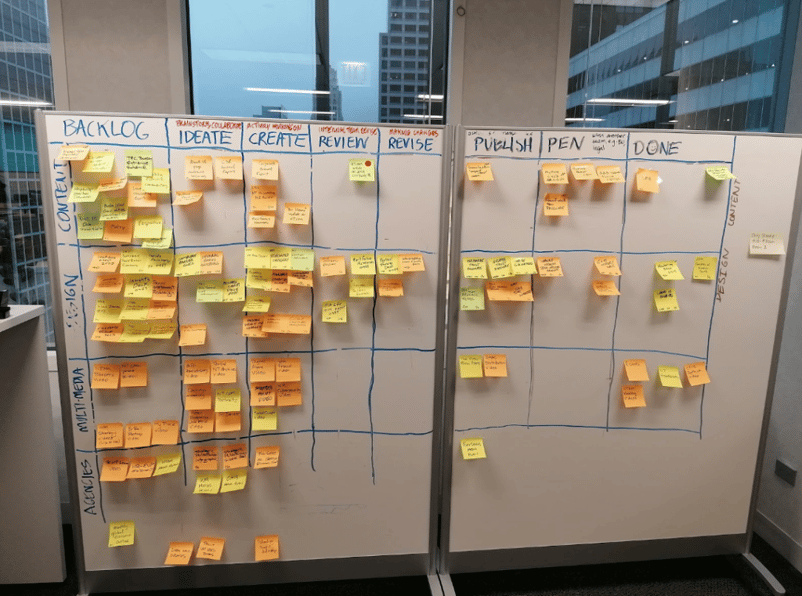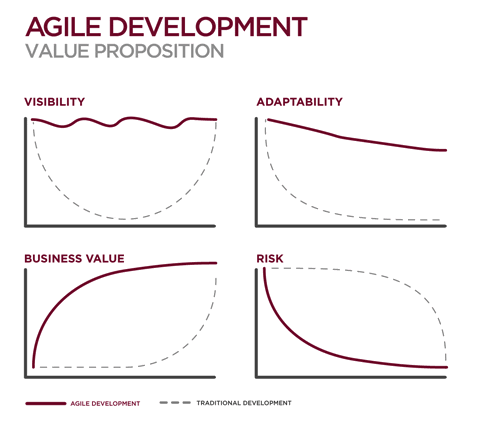-
- marketing agility
- Teams
- Organizations
- Education
- enterprise
- Articles
- Individuals
- Transformation
- Solution
- Leadership
- Getting Started
- business agility
- agile management
- going agile
- Frameworks
- agile mindset
- Agile Marketing Tools
- agile marketing journey
- organizational alignment
- Agile Marketers
- People
- Selection
- (Featured Posts)
- strategy
- agile journey
- Metrics and Data
- Kanban
- Resources
- Why Agile Marketing
- agile project management
- self-managing team
- Meetings
- Scrum
- agile adoption
- scaled agile marketing
- tactics
- scaled agile
- AI
- Agile Meetings
- agile marketing training
- agile takeaways
- Agile Leadership
- agile coach
- enterprise marketing agility
- Scrumban
- state of agile marketing
- team empowerment
- Intermediate
- agile marketing mindset
- agile marketing planning
- agile plan
- Individual
- Team
- Videos
- agile marketing
- kanban board
- Agile Marketing Terms
- agile transformation
- traditional marketing
- FAQ
- agile teams
- Agile Marketing Glossary
- CoE
- Scrumban
- agile
- agile marketer
- agile marketing case study
- agile marketing coaching
- agile marketing leaders
- agile marketing methodologies
- agile marketing metrics
- agile pilot
- agile sales
- agile team
- agile work breakdown
- cycle time
- employee satisfaction
- marketing value stream
- marketing-analytics
- remote teams
- sprints
- throughput
- work breakdown structure
- News
- agile brand
- agile marketing books
- agile marketing pilot
- agile marketing transformation
- agile review process
- agile team charter
- cost of delay
- hybrid framework
- pdca
- remote working
- scrum master
- stable agile teams
- stand ups
- startups
- team charter
- team morale
- user story
- value stream mapping
- visual workflow
.jpg?width=760&height=550&name=The%20Top%205%20Reasons%20NOT%20to%20Go%20Agile%20(and%20Why%20None%20of%20Them%20Matter).jpg)
When I wrote this, the world was in the midst of an outbreak of COVID-19, a.k.a. the Coronavirus, and preparing for an upcoming American election (oh, and maybe a recession too).
It was the perfect time for marketing teams to implement Agile ways of working.
Mid-2019, when none of these super fun circumstances existed, was also the perfect time for marketing agility.
Four years later, when the pandemic is in the history books it’s still the perfect time for Agile marketing transformations.
Agile processes are right for all of these points in time because they work in practically every situation marketers may find ourselves in. In the face of volatility, uncertainty, complexity, and ambiguity (also known as “everyday” in marketing), we can leverage Agile to get the right things done at the right time.
Yet, despite its near universal applicability, we’re always coming up with reasons to delay going Agile. So today it’s time to blow those all up.
No matter what’s going on, it’s the perfect time for marketing agility.
Delay Reason #1: We Need to Hire Person X
A certain spot on your org chart may feel like the lynchpin of your whole Agile undertaking; moving forward with it empty may feel downright foolhardy.
But no system, especially not an Agile one, should be dependent on a single point of failure.
Even when you do fill the open rec and bring on this new person, there’s unfortunately no guarantee they’re going to stick around forever (or even for a year).
For instance, we had a client who was waiting until they hired a full-time scrum master to start spinning up Agile teams. They made the hire, pushed the “start” button, and then their shiny new scrum master abruptly quit.
Another put things off until they brought on a new Vice President of Product. He stuck around longer than the transient scrum master, but as an executive he also had a lot of hoops to jump through in his first 90 days. There are lots of interviews, fact-finding, and general “getting up to speed” activities that occupy newly hired execs.
It wasn’t until after he’d been on the payroll for several months that he felt comfortable proceeding with any Agile-related changes.
In both these cases (and, I suspect, whatever one is facing your marketing organization), many months of testing, learning, and iterating in an Agile system were lost while they waited for the hiring stars to align.
These Agile transformations could be months ahead of where they are if they hadn’t delayed because of hiring.
Don’t wait for the unicorn to sign their offer letter. Start with the folks you have.
Delay Reason #2: We Don’t Have the Right Tools
Oh, Agile tools. How I both love and hate them.
I love:
- the ease of copy-paste workflows and templated cards that don’t have to be manually recreated
- the accessibility for remote team members to join in the Agile process
- the measurement capabilities that digital tools provide.
I love many things about digital Agile tools, but I hate when teams put them at the top of their transformation backlogs.
First of all, if you adopt the tool first, every process choice you make will be framed around what the tool can do, instead of what you actually need your process to do. This is like trying to learn to swim with one hand tied behind your back.
Maybe you won’t drown, but you’re certainly not going to enjoy swimming.
The only things you really need to start using Agile marketing frameworks are a willingness to change and a way to visualize your work. That last half can be simple sticky notes and sharpies; it doesn’t need to be a complex tool rollout.

Image from AgileSherpas Archives
Even if you’re a distributed team (either by choice or by necessity of quarantine) you can still use simple digital options that don’t require hours of onboarding to use. Here’s sample kanban board I built in Trello; feel free to copy it and start using it right now!
Maybe it’s not a workflow visualization problem, but another kind of tool limitation that’s holding you back. If you don’t have the right kind of automation, or your website CMS is locked down by IT, or your marketing data is questionable at best, these can all feel like insurmountable roadblocks.
But no matter the tooling shortcoming you’re facing, it isn’t stopping you from starting.
If you have a team of would-be agilists, you can get up and running. You may encounter martech roadblocks, but finding a workaround is a great use of your newfound marketing agility.
Delay Reason #3: Our Culture Can’t Support Agile
A recurring mantra around Agile implementations is that Agile is a mindset first and a set of practices second. Adopting Agile activities, such as daily standup, without also attacking the mindset behind them is a direct path to Agile theater.
When we do this we get all of the motion, and none of the results.
However, culture takes a loooong time to transform, and many Agile practices can be adopted quickly. Does that mean we shouldn’t make any efforts at process improvement until our entire culture has been overhauled?
Definitely not.

You do need to make efforts at adopting an Agile mindset across the organization, but certain Agile activities can be part of those ongoing changes.
Think of an Agile marketing transformation like a resolution to get healthier. One of the best ways to do that (according to the science of habit formation) is to start imagining that you’re already a healthy person.
Then, when faced with a choice, you simply ask what a healthy person would do, and do that.
Changing the underlying culture of your organization can work the same way. When deciding how to proceed, imagine your completely Agile marketing department. What would it do? How would it act? What sort of teams will it contain? What daily activities will it undertake?
Then start doing those kinds of things and you’ll build up an Agile culture over time.
Delay Reason #4: None of Us Have Used Agile Before
Adoption numbers from the 2019 State of Agile Marketing Report showed just under a third of marketers were using Agile; the 2020 and the following years' numbers show us a slight uptick, but marketers who haven’t used Agile still outnumber those of us who have.
So chances are you’re looking at a marketing department full of newbie Agile marketers.
You could use that as an excuse to delay, but in fact it’s a strength rather than a weakness.
New Agile marketing practitioners don’t have any bad habits to unlearn. They don’t have any Agile-related horror stories that make them hate the sight of a Kanban board. They’re a beautiful clean slate on which to write your own best practices.
The flip side to this is there are many common Agile errors, and a group of inexperienced agilists will have a tendency to make all of them if they don’t have education and guidance.
Throughout the years, the Annual State of Agile Marketing Reports cited a lack of training and knowledge as the main thing holding marketers back from greater agility, so you need to be prepared to address this hurdle.
Fortunately, there are now dozens of options for educating new Agile marketers.
There’s a customized Agile marketing certification accredited through ICAgile (AgileSherpas offers it online as well as in person), at least one webinar per month, several podcasts (plus many, many one-off episodes on marketing agility), over a dozen books (here are some of our favorites), and even a video series (this one’s mine; please pardon the shameless plug).
So yes, it’s likely that few of your marketers are experienced agilists, but this is a flimsy excuse not to seize all the benefits Agile marketing has to offer.
Delay Reason #5: Business Partners Aren’t Agile
Most (if not all) marketing teams have internal partners they need to work with to get things done. Regulated industries might need to coordinate with legal and compliance; other groups may bump up against sales, human resources, and/or product development.
Chances are, one (or more) of your internal business partners aren’t Agile (yet). And this is one of the most commonly cited reasons why marketers don’t go Agile themselves.
Once again, however, this delay tactic doesn’t hold up to scrutiny.
For the past couple of decades, software developers have been the only Agile game in town. In practically all organizations, they were an Agile island in a sea of traditional waterfall project management.
But they did it anyway.
Developers have clung to Agile, despite few colleagues who understand why the heck they stand up every morning for 15 minutes and talk about this weird board. They’ve done so because Agile is the best (and only) way to deal with the complex realities of the digital knowledge work they do.

Image source: VersionOne
Marketers have arrived at a similar point. Our old school ways of working aren’t cutting it anymore; our work is always delayed, there’s a huge amount of waste in our systems, we’re so busy we resort to cut-and-paste campaigns with no innovation -- the list goes on and on.
It’s true, a lack of organization-wide agility can be a challenge. But faced with the choice between adopting Agile inside our own sphere of control and getting our broken processes under control or staying stuck and stressed out until everybody else does it first, it’s pretty much a no brainer.
Bonus Excuse: Crisis Mode
Given the crazy place we all currently inhabit, I felt the need to sneak in one last bonus excuse here, because it's easy to blame our busyness for broken processes and systems. It might feel like the busy knob has been turned up to 11 right now, but that just makes it a more important time to improve the way you get things done.
You can put together a board, create a backlog, and start having daily standups today; there's no need to wait for a fancy transformation to start adopting Agile marketing, especially when it could save your sanity right now.
AgileSherpas is collecting multiple resources for marketing grappling with these issues (you can find our ever-growing list here), including our 80-minute Introduction to Agile Marketing that's now FREE!
I'm also sharing tips and tricks over on my YouTube channel, so again, you've go no excuse for not making your life better via Agile, even in the midst of super stress mode.
There Ain’t No Excuses
Whatever situation you’re facing, whether it’s tightening budgets, a new competitor, or a global pandemic, Agile offers a solution. There are plenty of excuses that you could cite as reasons to wait to adopt these transformative ways of working. But, none of them hold water.
Because the choice between agility and traditional ways of working isn’t a choice between change and the status quo. It’s actually a choice between survival and obsolescence.
To prepare your organization for the transformation, why don't you pause for a second and get our dedicated checklist before you leave this page?
Topics discussed

Andrea Fryrear is a co-founder of AgileSherpas and oversees training, coaching, and consulting efforts for enterprise Agile marketing transformations.
Improve your Marketing Ops every week
Subscribe to our blog to get insights sent directly to your inbox.




